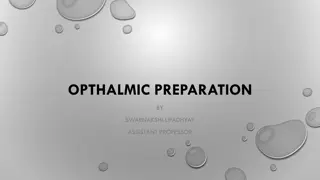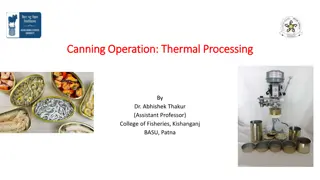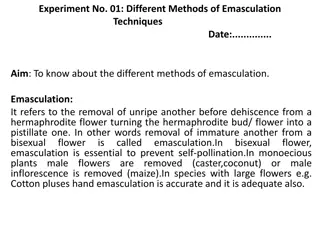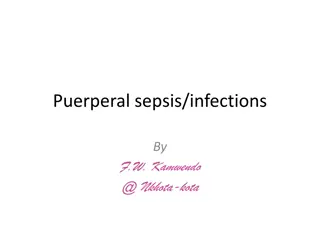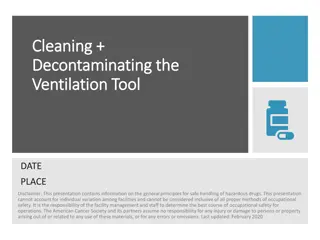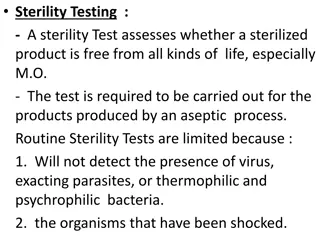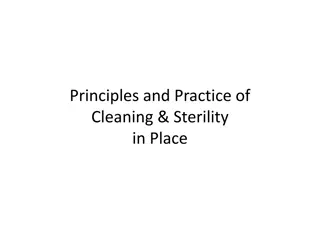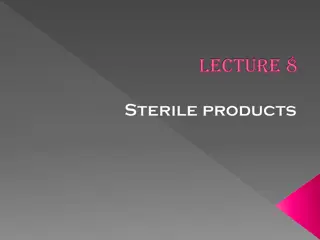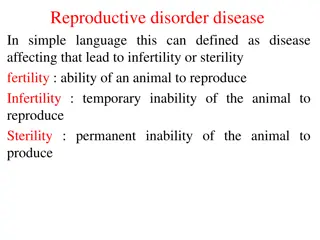OPTHALMIC PREPARATION
Ophthalmic preparations are essential for eye health, and their formulation requires careful consideration of factors like tonicity, pH adjustment, viscosity-imparting agents, stabilizers, antioxidants, surfactants, and preservatives. The goal is to ensure stability, bioavailability, and efficacy wh
1 views • 14 slides
Understanding Thermal Processing and Sterilization in Canning Operations
Thermal processing in canning operations involves heating sealed cans to specific time-temperature schedules to ensure consumer safety, prevent spoilage, and maintain product quality. While complete sterility is not the goal, commercial sterility is achieved to eliminate harmful microorganisms. The
2 views • 22 slides
Understanding Different Emasculation Techniques in Plant Breeding
Learn about the significance of emasculation in plant breeding to prevent self-pollination and facilitate controlled pollination. Explore various methods such as hand emasculation, forced open method, clipping method, emasculation with hot/cold water, alcohol, suction method, chemical emasculation,
2 views • 10 slides
Prevention and Management of Puerperal Sepsis and Infections
Puerperal sepsis and infections are serious conditions affecting women postpartum. Puerperal sepsis is characterized by specific symptoms, while puerperal infections are more general. Prevention includes antenatal care, strict intrapartum hygiene practices, and timely interventions. By following gui
2 views • 8 slides
Understanding Reproductive Disorder Diseases and Hormonal Infertility in Simple Language
Reproductive disorders can lead to infertility or sterility in animals, affecting their ability to reproduce. Causes include anatomical, functional, infectious, and management factors. Hormonal infertility may result from issues like cystic ovaries, delayed ovulation, or inactive ovaries. Conditions
0 views • 14 slides
Safe Handling of Hazardous Drugs - Ventilation Tool Cleaning Procedures
This presentation outlines the proper procedures for cleaning, disinfecting, and organizing ventilation tools, emphasizing the importance of trained operators following written protocols. It covers waste handling, documentation, and the use of personal protective equipment (PPE) for occupational saf
0 views • 24 slides
Validation and Sterility Assurance in Packaging Systems: Key Considerations
This content discusses the requirements for validating packaging systems and ensuring sterility, presented by Hartmut Dunkelberg from the University Medical Center in Goettingen, Germany. Key topics covered include the validation of basic operations such as emptying catheter bags, risks of contamina
1 views • 28 slides
Understanding Sterility Testing in Pharmaceutical Production
Sterility testing is crucial in assessing the absence of viable organisms in sterilized products. While it has limitations such as not detecting certain types of contaminants, various methods like direct inoculation, membrane filtration, and introduction of concentrated culture medium are employed t
0 views • 13 slides
Best Practices for Contamination Control in Pharmaceutical Manufacturing
Implementing a robust Contamination Control Strategy (CCS) as part of the Pharmaceutical Quality System is crucial for ensuring product quality and safety. The strategy encompasses various elements like process risk management, preventative maintenance, and personnel training. Manufacturers must foc
0 views • 19 slides
Principles and Practice of Cleaning and Sterility in Place
Cleaning in Place (CIP) and Sterilize in Place (SIP) are essential processes in large-scale industries where equipment and vessels are cleaned and sterilized without dismantling, ensuring product safety and quality. CIP involves the use of chemicals, sterilizers, and high-pressure equipment, while S
0 views • 36 slides
Understanding Sterile Pharmaceutical Products Development
Sterile products are dosage forms free of viable microorganisms, crucial for parenteral administrations to ensure therapeutic efficacy and patient safety. This article covers the importance of sterile products in the pharmaceutical industry, the development objectives, different routes of administra
0 views • 31 slides
Reproductive disorder disease
Reproductive disorders in animals can lead to infertility or sterility, affecting their ability to reproduce. Causes include congenital, hormonal, nutritional, infectious, and management factors. Congenital or hereditary causes may involve conditions like hermaphroditism, freemartin syndrome, and ov
0 views • 20 slides
